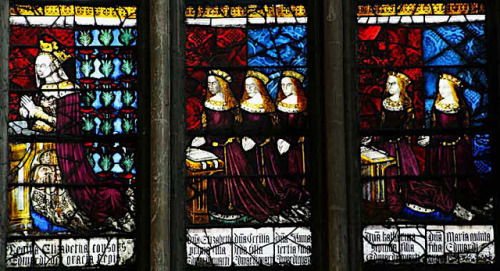Henry’s Coronation Was Followed Almost At Once By His Marriage. As His Mother Pointed Out In A Letter
Henry’s coronation was followed almost at once by his marriage. As his mother pointed out in a letter to Bellièvre, the surintendant des finances, savings would be made, notably in the distribution of gifts, by combining the king’s coronation and wedding. The marriage contract was signed on 14 February and the wedding followed next day. De Thou tells us that it was delayed till the afternoon because Henry took so long fussing over his attire and that of his bride, but royal weddings always took place then to allow time for the participants to recover from the previous previous evening’s festivities. Henry arrived at Rheims cathedral in pomp preceded by bugles and trumpets. Behind him walked the bride’s father, the count of Vaudémont. Louise’s cortège followed. Tall and blond, she wore a gown and heavy cope of mauve velvet embroidered with fleurs-de-lys. Her future brothers-in-law, the duc d’Anjou and the king of Navarre, walked on either side of her. Behind came Catherine de’ Medici and many princesses and other ladies. For once Catherine had set aside the mourning she had worn since her husband’s death in 1559. The wedding itself took place outside the cathedral’s main porch under a canopy of gold cloth. It was followed by a low mass within the cathedral celebrated by cardinal de Bourbon and the day was rounded off by a banquet and a ball at the archiepiscopal palace. According to a Venetian witness, the king and 12 princes wore suits of silver cloth adorned with pearls and jewels. The new queen, too, was superbly dressed.
Robert J. Knecht, Hero or Tyrant? Henry III, King of France, 1574-89 (pp. 105-106)
At first glance Louise de Lorraine looks like a Renaissance Cinderella story--the unappreciated young woman mistreated by her cold step-mother rescued by a handsome young king/prince--only to turn into a nightmare. Maybe that handsome king isn’t as stable as she first thought...and maybe he doesn’t really like her for herself, but because she looks a lot like his dead ex-lover who he idealizes...
How has no one written a Louise-centric novel casting her as Cinderella? The White Queen turned Elizabeth Woodville’s life into a Cinderella-gone-wrong story, it’s Louise’s turn.
More Posts from Ignorethisrandom and Others
As much fun as his character is, his ending is fan service. Good thing Bran can see the past and has maybe some inkling about the future. Maybe he can figure out how to get money in his spare time. Or he can write to Arya for help. In the books Arya is good at math and keeping figures.
Who wants to bet that within the span of one year, Bronn’s going to make Petyr Baelish look like the best master of coin in history?

historicwomendaily celebration week: Favourite Sisters
Elizabeth of York (11 February 1466 – 11 February 1503) was the eldest daughter of king Edward IV and his wife queen Elizabeth Woodville. Elizabeth was the Queen Consort of England from 1486 until 1503 as the wife of Henry VII and the first Tudor queen. She married Henry VII in 1486 following the latter’s victory at the Battle of Bosworth Field, which started the last phase of the Wars of the Roses. Uniquely, Elizabeth of York was a daughter, sister, niece, wife and mother of English monarchs - Edward IV, Edward V, Richard III, Henry VII and Henry VIII, respectively.
Mary of York (11 August 1467 – 23 May 1482) was the second daughter of Edward IV of England and his queen consort Elizabeth Woodville. In May 1480, Mary was named a Lady of the Garter along with her younger sister Cecily. There were reportedly plans to marry her to John, King of Denmark, bit nothing came of it as Mary died aged 14 at Palace of Placentia in Greenwich on 23 May 1482.
Cecily of York, Viscountess Welles (20 March 1469 – 24 August 1507) was an English princess and the third, but eventual second surviving, daughter of Edward IV, King of England and his queen consort Elizabeth Woodville. In 1474, Cecily was betrothed to the son of James III of Scotland and In 1482 - to the Duke of Albany, who had recently allied himself to Cecily’s father, who he died before a marriage to Cecily could take place. Cecily lived at court with her family through the autumn and winter of 1485-1486. She served as her sister’s chief lady-in-waiting once Henry and Elizabeth married that January, and she attended upon her sister throughout the spring and summer while she was pregnant with her first child. When Prince Arthur was born in September 1486, Cecily carried the infant during his christening. At some point in December 1487, when Cecily was 18, she married John, Viscount Welles, Margaret Beaufort’s younger half-brother. After his passing some years later, Cecily married without royal permission a commoner Sir Thomas Kyme, for which her estates were confiscated by Henry. One hopes that this final marriage enabled Cecily to find happiness away from court, but the record of her fades before her death at age 38 in 1507
Anne of York (2 November 1475 – 23 November 1511) was born in the Palace of Westminster, London, as the fifth daughter of King Edward IV of England and his wife, Elizabeth Woodville. On 5 August 1480, King Edward IV signed a treaty agreement with Maximilian I, Archduke of Austria for Anne to marry his son Philip, duke of Burgundy, but the treaty was repudiated after Edward’s death and never took place. In 1484 Anne had been betrothed to Thomas Howard by Richard III. This was one decision that Henry seemed to agree with, and the two were married in 1495 when Anne was nineteen years old. She spent some time at court serving her sister as lady-in-waiting, but little else is known of Anne of York. She found favour under Henry VIII, as evinced by gifts of estates made to her, but she died shortly after his ascendancy, leaving no surviving children.
Catherine or Katherine of York (14 August 1479 – 15 November 1527) was the ninth child and sixth daughter of King Edward IV by his wife Elizabeth Woodville. Catherine was one of many English princesses considered for a Scottish match before she was married to William Courtenay. He spent significant amounts of time in the Tower for his traitorous words regarding Henry VII’s reign before his death in 1511, shortly following his reinstatement as Earl of Devon by Henry VIII. Catherine and her husband were present at court on various important occasions, including the wedding of Arthur Tudor and Katherine of Aragon. Catherine seems to be a favourite aunt of Henry VIII and was enjoying great favour and gifts from him occasionally visiting court. The Courtenay family held great power in the west of England. Catherine, who had taken a vow of chastity after William’s death outlived the remainder of the children of Edward IV dying in 1527.
Bridget of York (10 November 1480 – 1517) was an English princess, the tenth child and seventh daughter of Edward IV of England and Queen Elizabeth Woodville, born less than three years before her father’s death. Bridget entered the Dartford Priory in 1490 at the age of 10, though it is unknown if this was to honour a plan of her father’s, her own wishes, or due to other reasons. Evidence of Bridget’s study of Catholic saints exists, and she spent the remainder of her life as a nun. She died in 1517, never foreseeing the dissolution of the priory that would occur under her nephew, Henry VIII.
pictured: Elizabeth Woodville and her five daughters (left to right): Elizabeth, Cecily, Anne, Catherine, and Mary. Royal Window (c.1482), Northwest Transept, Canterbury Cathedral.

“…I killed you…”
I get the feeling that before this is over he and Ceresi are going to get it on, at least once. He is her type after all. Why else cast an actor this attractive? He looks like Jamie does in the books.
I can imagine Ceresi sleeping with him, thinking it’ll placate him (a callback to the Euron scene in episode one), only for him to immediately reply:
Harry: “That was all well and good, but you still need to pay the gold cloaks our salary. Our real salary.”
I can’t wait for the memes if that happens.


Don’t judge, but I ship this new character, Harry Strickland, with Sansa
Let’s take a moment to appreciate David Benioff and Dan Wiess. I may not like everything about how Game of Thrones ended...but at least they finished something and completed the task they set out to do.

Errr Jonsa?
Fun Fact:
I learned this while researching for my Prince Hamid essay. Naturally reading about the Ottoman Empire leads you to learning about the Sultans and then by extension the Harem. I can’t find a place for this fact in my essay, but it left me absolutely hysterical with laughter for some time so here it is…
Prior to 1861, all artist renditions of the harem at the Ottoman palace had been done by men. Now I’m not sure if you’re aware, but the penalty for a man seeing a woman of the sultan’s harem was death. However, all these paintings were created and they resulted in so much romanticizing of the harem all throughout the western world. Beautiful women, dancers, lithe bodies, all generally partially naked just there and hanging out together. It was the college dorm fantasy of the time.
Enter Henriette Browne, a French painter, with royal and diplomatic ties, who travelled to Constantinople (among other places). She would paint there and usually favored eastern subjects. She enjoyed school scenes and scenes with women especially. Anyhow, she’s given access to the harem. Henriette is the first painter who sees the harem because she’s a woman and she was allowed by law to be there. She paints the harem, among other subjects, and returns to Europe.
Cue all of Europe’s collective gasp when she unveils her Une visite, interior de harem, Constantinople to the eagerly awaiting public. Her painting shocked and stunned them because she had actually been inside and painted no partially clothed women.

But where’s all the naked ladies?!
I get the feeling D&D really didn’t want Bran to be king, but did so because it was in George’s outline. Seeing how little Bran has done to be king (or deserve being king), they made Sansa Queen of the North because that at least makes more sense than King Bran.
Northern independence, and the people who keep defending it as an outcome on the show, continues to bother me. I like the idea of the breakup of the kingdoms in theory, but it should be a full dissolution. There is no point to the north becoming independent alone. If being part of a united realm is such horrible evil tyranny, then why isn't it horrible and evil for the remaining kingdoms? Why is it okay for them to be forced to kneel not only to a king but a Northern, and therefore foreign, monarch? Especially since at least two of them have a history of rejecting foreign rule.
And if things in the Six Kingdoms are actually going to be good and just and all that, then why is it necessary for the North to secede? They could just stay and be ruled over by the legal heir to House Stark and continue to reap the benefits of easy trade with the more winter-resistant kingdoms. The happiest years of Sansa's life were spent in a united realm, so what does she think this is going to give her? I'm pretty sure King Bran is how the books are supposed to end per GRRM, and my suspicion is that the showrunners wanted to upgrade Warden of the North Sansa to Queen Sansa in an attempt to dodge the accusations of misogyny naturally arising from the treatment of other female characters who aspired to rulership. This is empty pandering if I'm right, and I don't care for it.
-
 dohaeries liked this · 7 months ago
dohaeries liked this · 7 months ago -
 majowajutrzenka liked this · 1 year ago
majowajutrzenka liked this · 1 year ago -
 sylvanprincess liked this · 2 years ago
sylvanprincess liked this · 2 years ago -
 amelia1976 liked this · 2 years ago
amelia1976 liked this · 2 years ago -
 chicot-premier reblogged this · 2 years ago
chicot-premier reblogged this · 2 years ago -
 chicot-premier liked this · 2 years ago
chicot-premier liked this · 2 years ago -
 ignorethisrandom reblogged this · 2 years ago
ignorethisrandom reblogged this · 2 years ago -
 bethdelusional liked this · 2 years ago
bethdelusional liked this · 2 years ago -
 saturnwisteria liked this · 3 years ago
saturnwisteria liked this · 3 years ago -
 histoireettralala reblogged this · 3 years ago
histoireettralala reblogged this · 3 years ago -
 almhw85 liked this · 3 years ago
almhw85 liked this · 3 years ago -
 ignorethisrandom liked this · 5 years ago
ignorethisrandom liked this · 5 years ago -
 vegetativegod liked this · 6 years ago
vegetativegod liked this · 6 years ago -
 kateswynford liked this · 6 years ago
kateswynford liked this · 6 years ago -
 condesatristesse-blog liked this · 6 years ago
condesatristesse-blog liked this · 6 years ago -
 maximumphilosopheranchor reblogged this · 6 years ago
maximumphilosopheranchor reblogged this · 6 years ago -
 mllemontpensier liked this · 6 years ago
mllemontpensier liked this · 6 years ago -
 chicot-premier reblogged this · 6 years ago
chicot-premier reblogged this · 6 years ago















